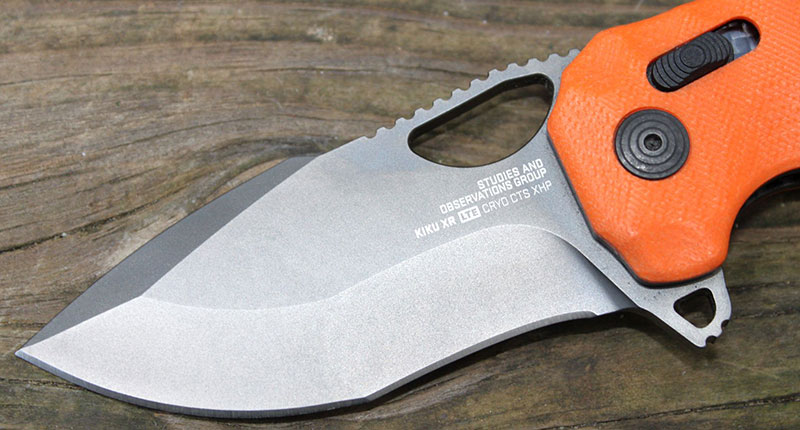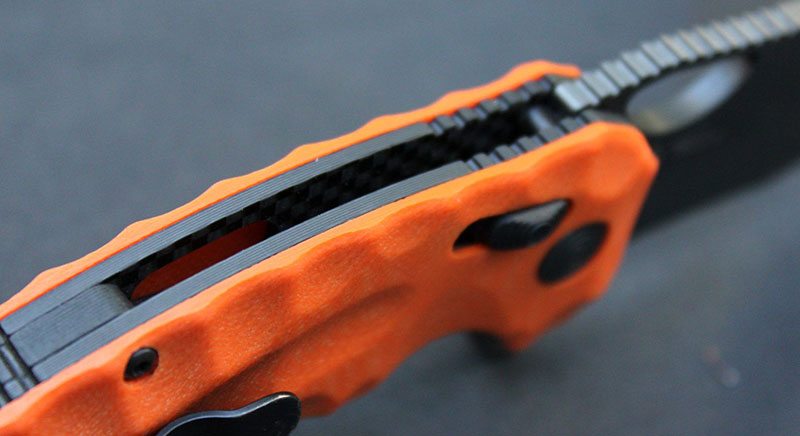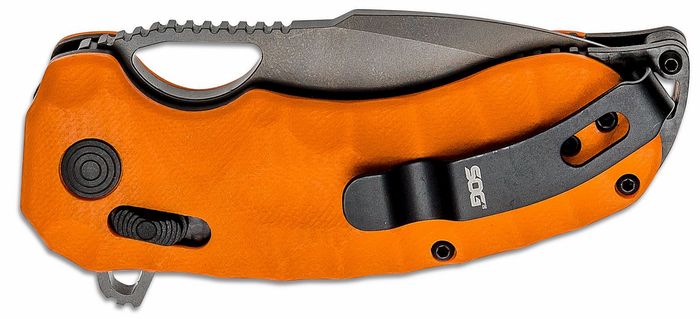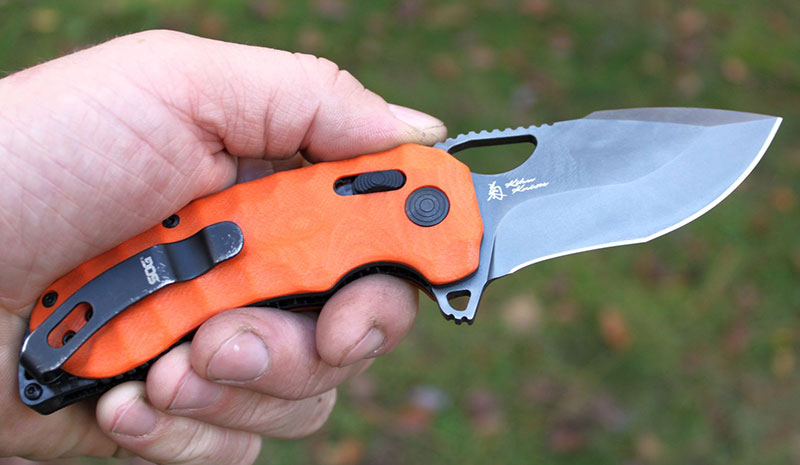We independently evaluate all recommended products and services. Any products or services put forward appear in no particular order. If you click on links we provide, we may receive compensation.

At the point I’m at in my knife collecting, carrying, using, and reviewing, it really takes a lot to surprise me. You could say I’m a little jaded, having tried and carried a little bit of everything over the two decades or so. I love knives, but to be frank, a lot of them are all very similar. There are certainly reasons for that – knives tend to perform best at a variety of tasks when they fit into a certain format. So to some extent, most really great EDC knives tend to have similar profiles. They look like Sebenzas, or Enduras, or Buck 110’s. They use a lot of the same mechanical features and designs.
SOG (Studies and Observations Group), they do make some of these knives. The Flash AT is very much a “conventional knife.” The subject of today’s review, the Kiku XR LTE, is decidedly not. Designed in collaboration with Kiku Matsuda, from tip to butt, this knife is weird, innovative, strange, bad, good, high tech and impressive. It’s also expensive. If you’re used to the SOG that sold you a Twitch II for $40 at a big retail store, the Kiku XR LTE’s $225 retail price(!) will come as a surprise. But it will make sense once you dive into why.

The big part of the why, and the reason why the XR LTE costs $35 more than the regular Kiku, boils down to materials. This knife, along with the Terminus XR LTE, are – as far as I know – the first full production folding knives in the world to use carbon fiber composite liners. Not scales – liners. This gives the knife tremendous strength as well as a noticeable drop in weight, although we’ll talk about that more later. And honestly, the carbon liners are just one of many interesting things about this knife. Let’s dive in.
Key Specs: SOG Kiku XR LTE
The Blade
The blade itself is quite complicated- even just describing its profile is a task. SOG calls it a Tanto, and I’d say it has elements of a Tanto (a pronounced secondary forward bevel with its own edge grind) but also a hint of harpoon grind and an intricate compound grind along the belly. A full flat ground drop point this is not. Even more complicated, the recurve portion of the edge has a hollow grind while the forward tanto portion has a flat grind (as does the false swedge along the spine.) The spine of the blade has a harpoon profile, with a dip down at the termination of the swedge and a long run of jimping as a traction spot for your thumb. The blade has both a flipper tab (which has a hole in it, as well as jimping for traction) and a thumb hole for deployment.

The blade itself is 3” long, cut from 0.15” wide blade stock. Blade steel is cryo-treated CTS-XHP, made by Carpenter Steel. XHP can be thought of in two ways – a higher-hardness 440C, or a more corrosion resistant D2. Or both. It has similar chemical compositions to both, but with more carbon (the primary determinant of hardness) than 440C (1.6 vs 1.0), and also more chromium (which defines corrosion resistance) than D2 (16 vs 11.5). It has similar amounts of manganese and molybdenum to both 440C and D2, and also has included vanadium (which D2 has but 440C lacks) for better wear resistance as well as smaller grain size for a cleaner edge.
What that means in real world difference – we must defer to the excellent Knife Steel Nerds, who has done extensive independent testing (including buying and repairing his own CATRA test machine!) which shows that XHP has increased toughness and edge retention versus 440C (5 vs 3.5 and 5.5 versus 4.5, respectively) while offering increased corrosion resistance (6.5 versus 4.5) relative to D2. All these numbers mean that XHP is a great all-around steel, staying sharp and resisting chipping while offering more corrosion resistance than the D2 that SOG uses in a lot of their knives. On top of that, SOG also coats this blade in a titanium nitride coating to further protect the steel from corrosion and abrasion.
Deployment & Lockup
The Kiku XR LTE is a manual-action XR Lock knife. This means it uses a sliding bar style lock that holds the blade closed as well as open. Deployment is aided by the used of ball bearing cassettes in the pivot to cut down on friction. The detent strength is a little light for my taste, but the frictionless ball bearings help to overcome that for pretty smooth deployment.

The flipper tab is funky, with a hole in the middle of it and jimping to locate your index finger securely, and it works more as a lightswitch (pull back) than a push button deployment style. There is some jimping in the ‘landing area’ on the spine, which I’m never a fan of, but it’s only on the liners not the scales and it’s relatively soft, so no big faux pas here. The thumb hole is an odd shape (flat on the top and rounded at the bottom), and while you can roll the blade open with your thumb fairly well I was never able to flick it with my middle finger or snap it open with a thumb flick due to the lower forward edge of the handle occluding the travel of your thumb.

Much easier to just pull back on the XR lock and wrist flick the blade out. Regardless of how you deploy the blade, the Kiku is easy to close – pull back on the lock and the blade will drop shut without any shake at all. Watch your fingers. When I first got the Kiku the lock bar dragged on the tang of the blade a bit (unless you were holding the lock open) but a bit of break-in as well as a few drops of oil on the lock bar and the tang make it incredibly smooth to open and close.
Lockup is very solid, SOG has really gotten the XR Lock dialed in to perfection. It uses a spring on each side of the lock bar to push it forward into place, and a beefy external stop pin locates the blade when open and closed, anchored in the carbon fiber liners. They say this lock will withstand 1,500lbs of force, a claim I’m not going to attempt to dispute because the thought of applying that much pressure to a blade is vaguely alarming. But there is no discernable blade play in either the vertical or horizontal directions when the blade is open.
Features, Fit & Finish
The main feature of the Kiku XR LTE are, obviously, the carbon fiber liners. It also uses a carbon fiber backspacer to drop weight, resulting in a 27% weight reduction versus the regular Kiku XR, coming in at 4.1 ounces versus 5.6. The dimensions of the knife are otherwise the same, it uses the same blade as well, so the weight reduction from the material change is pretty impressive. The liners and backspacer themselves are impressive to look at, especially when you peer down into the knife on a sunny day – the reflection off the glossy carbon fiber is pretty darn cool. They’ve also skeletonized the liners in places to further reduce weight, and the liners extend out past the end of the handle scales at the rear of the knife for access to the lanyard hole, giving a bright pop of the expensive space-age material.

Another interesting feature is the clip. You’ll notice in the pictures the clip is curved to match the shape of the handle, it slides into a slot between the scale and the liners and is secured by two screws. It’s a bent steel clip that’s very deep-carry (the top of the loop leaves only a tiny bit of the liners poking out) – you may be wondering how this works for left-hand carry, considering this knife is ambidextrous tip-up: the answer is it doesn’t. SOG includes a second clip in the packaging if you’re going to set the knife up for left hand carry that is a mirror image of the installed clip. It’s also a fully ambidextrous knife, with the lock, deployment, and clip all suitable for left hand carry equally to right.
The shape of the knife is pretty wild, and a lot of that is down to the scales, which are contoured G10 on my test sample (although the Kiku XR LTE is also available in black Micarta scales as well) in a super bright safety orange hue. They are some of the most textured scales I’ve ever seen, with a ring of scallops along the outside and a groove running down the center line. There’s also a thumb ramp cutout in the scales to make it easier to access the thumb hole. All of the screws on this knife are standard torx fittings, and with the width of the knife it makes sense that it uses two-sided construction, with two body screws as well as one screw through the protruding liner into the backspacer on each side, plus the pivot screw (which only has a torx slot on the side that is moveable.) SOG has toned down the billboarding on their new knives quite a bit – this one says “studies and observations group” and the model name and steel type in small font on one side, and the Kiku Knives logo on the opposite. A small SOG logo on the clip is the only other marking – no skulls in dashing berets on this one.

I will say, as far as fit and finish goes, this absolutely feels like a $225 knife. It’s incredibly light for how chunky it looks and feels, and I would say that SOG is up there for having the best and cleanest grinds on production knives – the Kiku has a very complicated blade, and the grind is clean and symmetrical. It came screaming sharp out of the box, too. Fitment between scales and liners is very good, the blade is perfectly centered between the scales when closed, and overall it’s a very well-made knife.
Field Test
First, let me get my biggest gripe out of the way. The Kiku XR LTE is difficult to get in and out of your pocket. The clip tension is very high (this thing will never slide out of your pocket on accident) and very little of it sticks out of your pocket, so it’s hard to get a hold of and it’s hard to retrieve smoothly. Also, the chunky nature of the handles means it doesn’t really carry very well, taking up a lot of pocket real estate relative to its size. It is pretty light – thanks to the carbon fiber – so it doesn’t weigh you down, but it’s not the best carrying pocket knife out there.

The upside to the bulky scales are good ergonomics, the mass of the handle filling your hand nicely. I would wish for a forward finger choil on a knife like this, but the scalloped handle with the flipper forming a finger guard makes for a secure four-finger grip, and the jimping on the spine gives your thumb plenty of traction. The curved pocket clip also reduced hot spotting in your hand.

The blade shape is very dramatic, but I still don’t really know what these compound grind recurved blades are good at, especially at only 3” long. The recurved portion does do a good job at cutting rope – the concave section traps the material against the edge and makes pull cuts easier, but in my experience most EDC cutting is piercing and push cutting, and for me a more normal cutting edge profile makes that stuff easier. It’s not that it won’t cut stuff, but tasks like cutting a foil seal off a bottle of oil or removing a stubborn zip tip that’s too tight to get a pair of wire cutters around is just more difficult with this dramatic blade shape than with a regular old drop point. It would also be pretty difficult to do any food prep with this blade. Also, there’s the matter of sharpening: while you can sharpen this yourself, you can’t do it (properly) with a guided rod style sharpener which normally gives you the most accurate results. This is the main reason I avoid recurved blades. It’s cool looking, but the practicality isn’t there for me.

No complaints about the lock or deployment, though – SOG really has these manual XR locks dialed in now. I also appreciate that the knife is fully ambidextrous, and it’s very safe – a strong lock that keeps your fingers out of the blade’s path when you’re closing it is a win in my book. The fidget factor is very high too.
Alternatives
All these knives available at BladeHQ.
While it’s fair to say that the list of knives with recurved blades, bar style locks, carbon fiber liners, and funky handles is precisely one item long, broadening the field of view brings some Benchmade knives into focus. None of them are an exact match for the Kiku, but maybe the closest is the Mini Freek, the 565-1 with carbon fiber scales and a high-performance CPM-S90V blade. Benchmade used to make a normal version of the Mini Freek (with G10 scales and coated M4 steel) that’s more similar to the Kiku XR but they discontinued it, so the high-end one (which costs about $40 more) is the closest Benchmade. It has a 3” flat ground drop point blade in stonewashed S90V with thumb studs, uses the AXIS lock, has full carbon fiber handles, and it’s a good bit lighter at 2.74 ounces – but it’s a lot less chunky of a knife.
The other bar-lock knife that’s worth comparing is the Hogue-manufactured Doug Ritter Mini RSK Mk1 G2, sold exclusively through KnifeWorks. It’s cheaper at $149 retail, and construction is a bit more traditional (steel liners with G10 scales in a variety of colors) but the 2.9” drop point blade is made from CPM-20CV steel, a useful performance upgrade over XHP, and it’s still quite light at 2.6 ounces. We reviewed the full-sized RSK G2 previously and loved it, so it’s safe to assume the Mini would be equally great.

It’s difficult to find other directly comparable knives, but the Kizer Sheepdog with carbon fiber scales does have a similarly funky feel, even if it’s not as high tech as the Kiku. The 3.25” Sheepsfoot blade uses CPM-S35VN steel, and ceramic ball bearings in the pivot makes the flipper deployment super satisfying. Weight is similar at 4.5 ounces, thanks to the chunky handles and stainless liners. Kizer makes excellent quality knives and the Sheepdog has long been one of their top sellers for its unique looks and blade shape.

Wrap-up
The SOG Kiku XR LTE is a very high-tech knife, and a very well-made one to boot. Everyone who handled it (myself included) was surprised by how light it felt compared to how heavy it “looked” – a trick that’s entirely down to the carbon fiber liners, a first for a full production folding knife. They’re very strong while dropping a considerable percentage of the knife’s overall weight, and I think that party trick is worth the $35 price premium over the regular Kiku XR. The XR lock works amazingly here, offering multiple deployment options with super smooth open and shut action and rock solid lockup.

As an everyday carry knife, I’m not convinced of its utility. I just don’t like compound grinds and recurves, as cool looking as I’ll freely admit that they are. Despite the weight savings from the carbon fiber liners, it’s still a chunky knife that takes up a lot of pocket space but doesn’t really have a very long blade or a lot of really useful edge length. It’s also difficult to get in and out of the pocket. So a practical pocket knife it is not.
But as a technological “look what we can do!” it’s impressive. And the good news is that if you like the LTE concept, SOG has some more ‘normal’ knives coming out in the near future that benefit from the weight reduction regimen – think Vision and Pentagon.
- First production knife with carbon fiber liners, significant weight reduction over stainless, very slick deployment and lockup, fully ambidextrous, cool looking
- Still kind of chunky, impractical blade shape, hard to dig out of your pocket, pricey
SOG Kiku XR LTE
Quality/Performance - 74%
Value for Money - 72%
73%
No one ever said the flagship had to be practical. It just has to be memorable... and the SOG Kiku XR LTE is just that.





